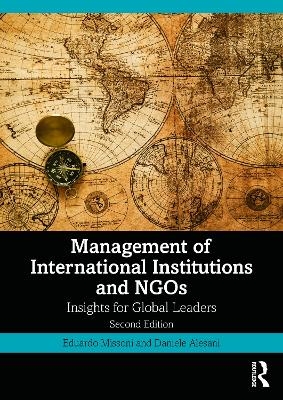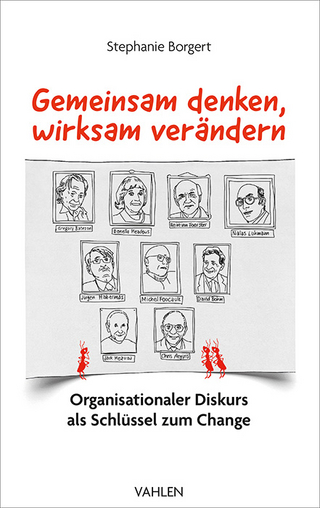
Management of International Institutions and NGOs
Routledge (Verlag)
978-0-367-13304-7 (ISBN)
This second edition of Management of International Institutions and NGOs covers all key topics in global governance from a unique management perspective. It analyzes the management challenges associated with international cooperation rather than the more commonly explored political or economic lenses.
This text is structured to enable students to connect theory with practice, beginning with the main management frameworks developed in the context of corporate and national public/nonprofit organizations and adapting them to the specificity of international institutions and international non-governmental organizations. This leads to the identification of a “tailored” approach to international organization management based on their institutional and operational settings, stakeholder groups, core business, staff profiles, and financial arrangements. The authors then connect this theory with practice by linking frameworks to several case studies and best practices of organizations currently experimenting with management systems and tools, with case studies including the World Bank and the Gates Foundation.
This edition has been extensively revised and updated, with an expanded conceptual framework inclusive of systemic theories of organization, new cases throughout, and new chapters on leadership, supply chain and operations, and human-centered digitization. This comprehensive textbook is a must-own resource for students and academics involved with studying and working with international organizations.
Professor Eduardo Missoni is a medical doctor with extensive experience in international development cooperation and global health. He is an Adjunct Professor at the SDA Bocconi School of Management, a Visiting Professor at several universities in Italy and abroad, and a former Secretary General of the World Organization of the Scout Movement. Dr Daniele Alesani is a senior United Nations system professional and an Academic Fellow at the SDA Bocconi School of Management. He has worked for over a decade as international civil servant in several International Institutions and authored original research on managerial reforms in the multilateral sector.
Foreword
Acknowledgments
List of Abbreviations
Introduction
1 International institutions: classification and main characteristics
1.1 Introduction
1.2 Toward a definition of international institutions
1.3 Possible classifications of international institutions
1.4 The United Nations system
1.5 Global and regional international financial institutions
1.6 Other families of IIs
2 International non-governmental organizations: definitions, classification, and relation with the UN system
2.1 Defining NGOs
2.2 Non- profits
2.3 Civil society
2.4 Third sector and social economy
2.5 In search of operational definitions
2.6 Other transnationally operating non-profits
2.7 NGOs and the UN system
3 Transnational hybrid organizations, multistakeholder initiatives, and partnerships
3.1 Introduction
3.2 Defining and classifying multistakeholder initiatives, transnational hybrid organizations, and global partnerships
3.3 Organizational arrangements of THOs and other public– private interactions
3.4 Lessons learned and challenges
3.5 From the idea of “partnership” to multistakeholderism. A historical overview
3.6 Case study: the UN opening to the corporate sector – the Global Compact
3.7 Case study: the Global Fund to Fight AIDS, Tuberculosis and Malaria
4 The evolution of international development cooperation
4.1 The birth of development discourse and international aid
4.2 Critics from the South
4.3 Applying the “shock doctrine”: the neoliberal response to crisis
4.4 Fight against poverty, partnership, and development goals
4.5 Financing for development
4.6 The Global Agenda 2030 for sustainable development
4.7 In search of aid coordination and effectiveness
4.8 The aid transparency movement
4.9 Development and the future of international cooperation and aid
5 Coordination and coherence among the actors of the international development system
5.1 From aid effectiveness to system-wide coherence and coordination among development actors
5.2 A decade of UNDS reforms in review: “Delivery as One” and UNDS repositioning to deliver on Agenda 2030
5.3 The “value chain” as conceptual lenses for UN system reforms
5.4 Policy and governance
5.5 Funding for development
5.6 Needs assessment planning and programming
5.7 Program implementation and business operations
5.8 Benefits, challenges, and open issues of UNDS reforms
5.9 An inconvenient dilemma for the UNDS reform initiatives
5.10 Looking beyond UNDS coordination – the case of the global action plan for healthy lives and well-being for all
6 Changing paradigms for program implementation
6.1 A new role for IIs in technical cooperation programs’ implementation: status and challenges
6.2 The changing aid environment and a new role for development actors
6.3 IIs: from “transactional” to “strategic” management of implementing partners’ relations
6.4 Capacity building as essential element of the transition to national execution of technical cooperation projects
6.5 Progress to date and future challenges
7 The evolution of IIs’ funding and financing for development mechanisms
7.1 Introduction
7.2 Bilateral and multilateral funding for development
7.3 IOs’ funding sources and mechanisms
7.4 The escalation of non-core resources, its impacts on financial and operational management, and efforts to strengthen sustainability and system-wide coherence
7.5 Results-based aid and financing
7.6 Blended and innovative financing for development
7.7 From funding to financing for development – thriving a “post-budgetary” world
8 Coordination in humanitarian response and the nexus with development
8.1 The humanitarian assistance landscape and evolving coordination strategies
8.2 Drivers and types of coordination in the humanitarian sector
8.3 Spectrum of humanitarian coordination and the need for a contingent approach
8.4 Overview of humanitarian coordination reform efforts
8.5 Humanitarian coordination roles and mechanisms
8.6 The humanitarian program vycle and inter-agency coordinated appeals
8.7 Joint and pooled humanitarian funding mechanisms
8.8 The nexus between humanitarian and development assistance
8.9 Selected open issues with humanitarian coordination
9 Governance models and reforms
9.1 Governance in IIs and INGOs: definition and key concepts
9.2 Institutional governance: organizational arrangements and the “rules of the game”
9.3 Decision-making mechanisms in IIs and INGOs
9.4 Good governance in IIs and INGOs
9.5 International regimes and global governance
9.6 Conclusions
9.7 Case study: governance structures at the ILO and the ITU
9.8 Case study: UN Security Council – veto power and reform proposals
10 Strategic thinking and planning
10.1 Introduction
10.2 The notion of strategy and the need for a tailored approach to public sector organizations and NGOs
10.3 The growing importance of strategy and strategic management in public and intergovernmental organizations
10.4 Toward a working definition of strategy for IIs and INGOs
10.5 Strategy formulation in IIs and INGOs: “thinking” and “planning”
10.6 Managing strategy in IIs and INGOs
10.7 Case study: new strategic decisions made by IFAD
11 Results-based management
11.1 Results-based management in international development
11.2 RBM as a management cycle
11.3 Key concepts and building blocks of RBM
11.4 The RBM information system in IOs and the results-based budget architecture
11.5 Specificities, challenges, and maturity of RBM in international organizations
11.6 Does performance matter? A donor’s perspective
12 Financial management – budgeting, reporting, and leveraging financial data
12.1 Introduction 306
12.2 Basics of accounting in public and non-profit organizations
12.3 Budgeting processes and budget structure in IIs
12.4 Benefits of the transition to accrual basis accounting and reporting
12.5 Using financial information to support operational decision-making
13 Human resources management
13.1 Introduction
13.2 The need for a tailored approach to HRM in IOs
13.3 The evolution toward strategic HRM in international organizations
13.4 The HR management cycle – main phases, open issues, and good practices
13.5 The future of HRM reforms in international organizations
14 Humanitarian operations and supply chain management
14.1 Defining humanitarian supply chain
14.2 The role of supply chain in disaster management
14.3 Components and specificities of the humanitarian supply chain
14.4 Gaps, critical success factors, and maturity of humanitarian supply chain
14.5 The “performing” humanitarian supply chain: trade-offs and strategies
14.6 Selected humanitarian supply chain partnerships
14.7 Strategic and operational impacts of the transition to cash and voucher assistance on humanitarian organizations
15 Digital transformation in IOs – toward a human-centered approach
15.1 Introduction
15.2 Digital transformation and its impacts on international organizations
15.3 Digitalization pathways of modern international organizations
15.4 FIR applications for business processes in IOs
15.5 FIR applications for program management and policy advocacy in IOs
15.6 Maturity of IOs’ digital transformation efforts – UN system assessment
15.7 Organizational preparedness to digital transformation
15.8 Assessing the preparedness for human- centered digital transformation and looking ahead
15.9 Case study – the introduction of blockchain technology for cash-based humanitarian assistance
16 Building and managing the organization’s profile
16.1 Introduction
16.2 Communication and branding
16.3 Stakeholder management
16.4 Resources mobilization
16.5 The web and social media as a “system”
16.6 Case study. Communication and the challenge of Infodemics
16.7 Case study: the management of strategic partnerships with civil society organizations at UNICEF
17 Leadership
17.1 Introduction
17.2 The challenges ahead
17.3 Leading international organizations
17.4 Being a leader in the global environment
17.5 Conclusions
18 Ethics and international organizations
18.1 Introduction
18.2 Defining ethics
18.3 Ethics of international organizations
18.4 Ethics in international organizations
18.5 The ethical versus unethical organization
18.6 Conclusions
18.7 Appendix: main fields of study in ethics
19 Conclusions
Bibliography
Index
| Erscheinungsdatum | 02.09.2023 |
|---|---|
| Zusatzinfo | 26 Tables, black and white; 83 Line drawings, black and white; 83 Illustrations, black and white |
| Verlagsort | London |
| Sprache | englisch |
| Maße | 174 x 246 mm |
| Gewicht | 1000 g |
| Themenwelt | Sozialwissenschaften ► Politik / Verwaltung |
| Wirtschaft ► Betriebswirtschaft / Management ► Planung / Organisation | |
| Wirtschaft ► Volkswirtschaftslehre | |
| ISBN-10 | 0-367-13304-0 / 0367133040 |
| ISBN-13 | 978-0-367-13304-7 / 9780367133047 |
| Zustand | Neuware |
| Haben Sie eine Frage zum Produkt? |
aus dem Bereich


